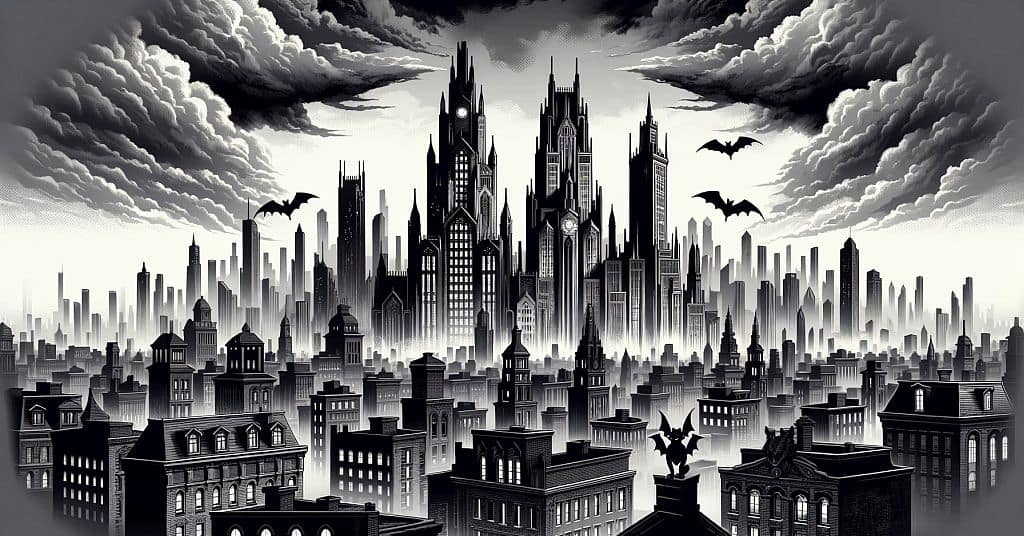 Bob Kane and Bill Finger envisioned Gotham City as a dark, gritty representation of New York City’s urban landscape.
Bob Kane and Bill Finger envisioned Gotham City as a dark, gritty representation of New York City’s urban landscape.
Gotham #
Which city was a template for Gotham? #
The fictional city of Gotham, famously known as the setting for DC Comics’ Batman series, draws inspiration from various sources, but it is primarily modeled after New York City. The creators of Batman, artist Bob Kane and writer Bill Finger, initially envisioned Gotham City as a dark, gritty representation of New York City’s urban landscape, embodying the complexities, crime, and corruption that could spawn a vigilante like Batman.
The term “Gotham” itself predates Batman, having been used by Washington Irving in the 19th century as a nickname for New York City in his satirical work. This nickname was adopted as a way to parallel the dark, chaotic energy of New York City with the fictional setting meant to house Batman’s tales of crimefighting. Over the years, Gotham’s depiction has evolved, incorporating elements from other cities such as Chicago and Pittsburgh, especially in its cinematic portrayals. For instance, the film “The Dark Knight” trilogy, directed by Christopher Nolan, extensively used Chicago to represent Gotham City, capturing its modern architecture and urban atmosphere.
Gotham City’s architecture and mood are heavily influenced by the noir genre, with its urban decay, crime-ridden streets, and shadowy aesthetic drawing from the 1930s and 1940s American cities. The city’s portrayal often includes Gothic architectural elements, contributing to its ominous and foreboding atmosphere. This setting serves as a backdrop for exploring themes of justice, morality, and the complexity of heroism within the urban American landscape.
In essence, while Gotham City is a fictional locale, its conceptual foundation is deeply rooted in the real-world dynamics and visual characteristics of New York City, enriched by elements from other cities and the creative imaginations of its many storytellers over the years. Gotham serves as a mirror to the societal issues and architectural grandeur that define urban America, making it a compelling, if foreboding, character in its own right within the Batman saga.
What are the distinctive characteristics of the fictional Gotham? #
Gotham City, as a fictional setting within the DC Comics universe, particularly in the Batman series, is distinguished by several key characteristics that set it apart from not only real-world cities but also from other fictional cities. These features contribute to Gotham’s unique identity as a dark, complex environment that reflects and amplifies the themes of the Batman narrative:
Gothic Architecture: One of the most visually striking aspects of Gotham City is its Gothic architectural style. Skyscrapers, cathedrals, and bridges often feature exaggerated Gothic elements, such as gargoyles, arches, and spires, creating a sense of foreboding and grandeur. This architectural choice enhances the city’s atmosphere, making it a place of shadow and mystery, perfect for the nocturnal activities of Batman and his adversaries.
Urban Decay and Crime: Gotham is often portrayed as a city suffering from extensive urban decay and rampant crime. High levels of corruption within political, financial, and law enforcement institutions contribute to a pervasive sense of lawlessness. This environment of moral and physical decay serves as a fertile ground for the wide array of villains in the Batman series and justifies the need for a vigilante hero.
Wealth Disparity: The city showcases extreme contrasts between wealth and poverty, with affluent citizens living in opulent skyscrapers or sprawling estates, while much of the population resides in impoverished, crime-ridden neighborhoods. This disparity highlights the social and economic issues that Batman, as Bruce Wayne, attempts to address both as a philanthropist and as a superhero.
Atmosphere of Fear and Suspicion: Gotham City is imbued with a palpable sense of fear and suspicion, partly due to the unpredictable nature of its many villains and the resultant frequent crimes. The city’s residents live in a constant state of vigilance and distrust, which Batman both alleviates and, in some interpretations, inadvertently contributes to through his intimidating persona.
Iconic Locations: Gotham is home to several iconic locations that have become integral to its lore, including Wayne Manor, the Batcave, Arkham Asylum, the Gotham City Police Department (GCPD) headquarters, and the Iceberg Lounge. Each of these locations serves as a key backdrop for the series’ narratives, contributing to the city’s rich, complex world.
Cultural Melting Pot: Reflecting its New York City inspiration, Gotham is often depicted as a cultural melting pot, with diverse neighborhoods and communities. This diversity adds depth to the city’s character, providing varied backgrounds and motivations for both its citizens and the myriad of villains that challenge Batman.
Perpetual Night and Weather: Artistically, Gotham is often enveloped in night or shrouded in fog, with a color palette that leans heavily towards blacks, grays, and muted tones. Rain, fog, and snow are common, contributing to the city’s oppressive and claustrophobic atmosphere.
Supernatural and Sci-Fi Elements: While grounded in crime and noir, Gotham also serves as a stage for supernatural and science fiction elements within the Batman narratives. This includes the use of advanced technology, the presence of characters with superhuman abilities, and occasional incursions by otherworldly forces.
These characteristics work together to create a city that is more than just a backdrop for Batman’s activities; Gotham itself is a central character in the Batman saga, reflecting and amplifying the themes of justice, corruption, redemption, and the dual nature of humanity. Its design and ethos resonate deeply with the complex narrative of Batman, making Gotham an unforgettable and integral part of the superhero’s mythos.